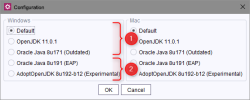Categories and selection
Crownpeak selects suitable Java versions for its customers and partners and tests them extensively.
The Java versions selected by Crownpeak can basically be divided into two main categories:
- Stable
- Experimental
Selecting a Java version is like using a “time machine” as it is possible to select
- past
- present
- or future stable
Java versions.
In order to take the temporal aspect into account, the two main categories mentioned above are divided into five subcategories:
Stable | Experimental | |
|---|---|---|
Present | Default | |
Stable | ||
Past | Outdated | |
Future | Early Access Program (EAP) | |
Experimental | ||
The categories from the table are listed in the same order in the configuration dialog (see Configuration).
The configuration dialog lists the two main categories and the five subcategories.
The “Stable” main category (1) is displayed in the top of the “Windows” and “Mac” areas. The “Experimental” main category (2) is displayed below that.
The “Default”, “Stable”, and “Outdated” subcategories are listed from top to bottom in the “Stable” block.
The “Experimental” block, meanwhile, contains the “EAP” and “Experimental” subcategories.
 |
After updating a module, a previously selected Java version that is no longer included is always displayed in second place (as “Custom Java”), regardless of its original category: |
Thanks to this arrangement of the Java versions, it is possible to select an appropriate version.
A version that is listed at the very top of the dialog has been “extensively tested by Crownpeak”. In contrast, a version that is at the very bottom of the dialog box has “not (yet) been thoroughly tested by Crownpeak”.
 |
As a rule, a maximum of one Java version per subcategory is offered in the module. |
The individual subcategories are described in detail in the following chapters.



